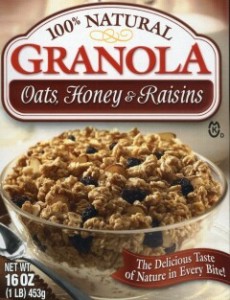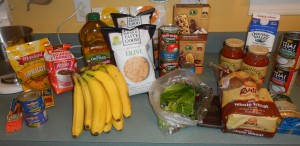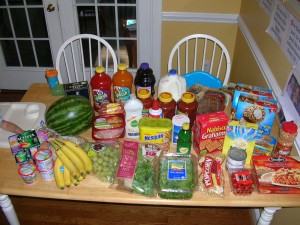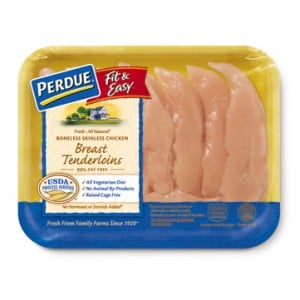Hooray, we got more than 25 fans, which means I can upload my status reports to Twitter!!
Wah, wah, wah. Who really cares about that? Boy was that ever a let-down. I don’t even do Twitter. Nonetheless, I am thrilled to have many of you as Eating Poorganically Fans on Facebook.
Before we get TOO much further into this fun world, I just want to clarify a few definitions as I understand them so far from my research. I’m also, finally, going to give you the ACTUAL definition for Eating Poorganically. I’m sure as I continue this process my opinions may evolve. As always, I rely on my “organic friends” to comment and fill in the gaps of my explanation. Check the links to see a more complete bit of info.
 ORGANIC: USDA certified organic products are verified by the USDA- FDA as being without pesticides, antibiotics, hormones or any genetic modification. A product may be labeled as “100% organic”, “organic” (95% organic ingredients), or “contains organic ingredients”.
ORGANIC: USDA certified organic products are verified by the USDA- FDA as being without pesticides, antibiotics, hormones or any genetic modification. A product may be labeled as “100% organic”, “organic” (95% organic ingredients), or “contains organic ingredients”.
A few thoughts from me . . . The problem with this labeling is that A LOT of food that actually is organic is not certified because the process is tricky, expensive, and time consuming. Secondly, in some cases the labeling is stupid because organic fish, for example, has to be farm raised so its food can be monitored. This is counter-intuitive to the idea of preferring “wild-caught fish” which may have eaten anything in the ocean.
The advocates for organic foods seem to both love and hate the labeling system. They want all foods labeled to be completely clear what is in them; however, some purists don’t even think the requirements of the USDA Organic checker-people are strict enough, so they don’t trust the label anyway. It’s like the labelers are danged if they do and danged if they don’t. (C’mon people, seriously? Did you read too much Charlotte’s Web? I think ya’ did. Eat the pig already.)
 In the case of produce, however, I did learn one helpful trick. Technically, the PLU sticker on the fruit for conventionally raised fruit should be FOUR digits. (Conventional produce can use pesticides and waxes.) Genetically modified produce should have a PLU sticker with FIVE digits the first of which is 8. Organic produce has a FIVE digit PLU, the first number of which is 9.
In the case of produce, however, I did learn one helpful trick. Technically, the PLU sticker on the fruit for conventionally raised fruit should be FOUR digits. (Conventional produce can use pesticides and waxes.) Genetically modified produce should have a PLU sticker with FIVE digits the first of which is 8. Organic produce has a FIVE digit PLU, the first number of which is 9.

NATURAL: Basically, the word “natural” could mean that something is in its natural state OR it could simply mean naturally derived junk is in the product. Apparently there is not oversight for the use of the term. Manufacturers can call products “natural” if the products in it are derived from nature. Practically EVERYTHING (including weed, heroin, and cocaine) is derived from nature. In fact “nature” seems to include just about all of the vast amount of products (high fructose corn syrup, malodextrin, hydrogenated oils, ect.) not made by nuclear fusion. Also, genetically modified crops and their derivitives can also be called natural.
 A few of my thoughts: This is not to say that a NATURAL is bad; it is just kind of meaningless. It is like a village midwife with no credential. She could be awesome and helpful and knowledgeable; she could be a terrible, squeamish rookie. There’s no way to know without just letting her atcha’. 😉 Similarly, in the case of these foods, you really need to look at the ingredients and think through whether it is something like “All Natural Tomatoes” with ingredients “Tomatoes, salt” or “All Natural Tortilla Chips” with a list of ingredients as long as your arm, half of which are unpronounceable.
A few of my thoughts: This is not to say that a NATURAL is bad; it is just kind of meaningless. It is like a village midwife with no credential. She could be awesome and helpful and knowledgeable; she could be a terrible, squeamish rookie. There’s no way to know without just letting her atcha’. 😉 Similarly, in the case of these foods, you really need to look at the ingredients and think through whether it is something like “All Natural Tomatoes” with ingredients “Tomatoes, salt” or “All Natural Tortilla Chips” with a list of ingredients as long as your arm, half of which are unpronounceable.

REAL: Real food is food that is as close to its natural state as possible. It excludes processed foods, artificial foods, GMO foods, and, to some degree, non-organic foods. However, Real Foodies, like my girl, Lisa at 100 Days of Real Food (she doesn’t know she’s my girl, but she is) don’t even buy things like organic granola bars because they are still heavily processed, just with organic ingredients. She doesn’t use ANY refined flours or sugars or any foods with more than five ingredients. If it requires more than five ingredients, she makes it from scratch, using the requisite “real foods.” She grinds her own wheat and makes cake with whole wheat flour. (I’m sorry folks; that is just wrong. I love The Pioneer Woman too much for that.)
My thoughts on this: I think avoiding processed foods is good and she has definitely created some awesome menus; however, I’m not ready to give up sugar and start grinding my own wheat. I think that the five ingredient rule is a good one though. I have realized that we ate more processed food than I realized once I considered that many breads and cereals are actually “processed.” Duh.

Eating Poorganically Definition: After my initial research, I think my motto is “Consider the Source.” This applies both to food and information. Here’s a few guidelines (not rules) that I’m following for now.
1. For fruits and vegetables, I’m going to focus on buying locally and washing thoroughly, while avoiding genetically modified produce. If an item is on the “Dirty Dozen,” I may consider buying the organic option OR just try to do a better job of washing to remove pesticides. There is VERY conflicting evidence about the residual presence of pesticides on plants AND about how damaging those may or may not be, so I’m considering the source with that information as well. Check out Facebook to see the method of washing produce that I’ve adopted.
2. For meat, eggs, and milk, I’m going to try to buy organic or from a reliable source that is free of genetically modified feeds, hormones, and antibiotics. At this point, it seems reasonable to think these things should not be in our food supply although, in point of fact, this also is NOT proven. While purists will tell you not to trust the labels of manufacturers like Perdue, who are not organic but make claims like “all vegetarian feed,” “no animal by-products,” “and cage-free,” I will probably trust these claims UNTIL they prove themselves untrustworthy to my knowledge or experience. I refuse to be swayed by hyped-up conspiracy theories or documentaries. It is just not my way.
Incidentally, I did notice that there is a label on ALL chicken that says the use of steroids and hormones are prohibited in poultry by the USDA. Additionally, many non-organic milks indicate that they do not come from cows who are given hormones (rBst). That is to say, Eating Poorganically means that you can be a label reader, a smart shopper, and get around buying exclusively organic. (Purist Organics tend to believe that you are “guilty” until certified organic, but that is not the EP way.) Just consider your source.
3. For the remaining foods, I’m going to follow the five ingredient Real Food rule OR TRY to buy organically. When I’m not buying organic items, I’m going to try to do a better job of avoiding artificial ingredients, refined grains and sugars, preservatives, and ingredients that could be derived from unlabeled genetically modified crops (like high fructose corn syrup or sugar, which I learned is often derived from GM sugar beets unless it says 100% cane sugar). I really have to read labels for this, but there are many great options for foods that are perfectly within these criteria that are not necessarily organic.
4. (Rule 4 is my favorite.) However . . . . .when I’m out of my house, I can eat whatever I want or whatever I am served, with a smile. I can eat any food someone gives me with love. I want Eating Poorganically to be about being healthy, making good choices, and teaching my kids to do the same. I don’t want this to be about legalism, obsession, exclusion, or guilt. So while I hope that we will make good choices at home and away from home, the point is to make realistic choices. For example, when my mom showed up at my door yesterday with Chocolate Truffle Cheesecake, did I say, “I’m sorry mom; is this organic?” No, I did not. Did I feel bad eating it? No, I did not. I felt awesome. Did I feel bad watching Anika eat it? No, I did not. (Well, actually, I kind of regretted giving her such a big piece because it made less for me, but other than that, I did not.)I considered the source: Mom, the best Cheesecake Maker and baker on the planet. Nuff said.

5. We are going to eat any and all processed or other food that is currently in our house till it is gone. In my opinion, wasting is worse than being poisoned by pesticides or genetically modified by Monsanto. You can throw out all of your ketchup, mayonnaise, and Frosted Mini Wheats to start from scratch, but I am not doing that. If necessary, we will replace these items with smarter choices as we go.
6. I’m going to do all of that for $85-$100 a week. (Unless it was last week, when I didn’t. But starting NOW, I am.)
So any questions about the Eating Poorganically Definition?
(Can someone invite me over and offer me doughnuts? I’ve been craving them.)


ok, so your closing picture… we don’t eat processed foods, but i love the idea of couponing. so i am interested in how you can coupon and eat poorganically. is this possible?
Do you mean the ACTUAL closing picture where I show all the processed food we used to eat (and are eating up till it’s gone)? Yes, I am going to phase that out–unless it’s organic or under five or something I deem okay, like a bag of chips with 11 ingredients, all of which are non GMO and things that I like, such as Sunflower oil and sesame seeds. Yes, you can coupon Poorganically. I am doing it. There are coupons for “single source” organic items like cheese, milk, and meat; plus there are coupons for organic brands. It is not quite as easy, but it can be done. Also, I feel okay about couponing for conventional foods with acceptable and short ingredient lists. (ie: Tomatoes, salt) For example, I am going to continue buying N.O. 100% juices which are easy to get coupons for. Pineapple is the only GMO fruit, so apples, grapes, etc are okay. I feel that juiced fruit is pretty well washed from pesticides, so I’m allowing those juices (easily couponable) into our diet. 🙂
Reading labels is the key. I teach my fifth graders all about labels and smart food choices in our Nutrition unit. They are always amazed that sugar, corn syrup, honey, molasses, brown sugar, all the “-ose” sugars, etc. can be separated in the ingredients list to keep “sugar” from being the number one ingredient. The five ingredient rule is a good one. My kids don’t do the shopping yet (someday they will and hopefully will remember the lessons), but I’ve had parents call and tell me their kid went through the pantry and told them they shouldn’t be eating a bunch of the stuff in there. 🙂
It’s also tough to coupon for organic here. I have never seen a produce, milk or eggs coupon. Just about everything I can get coupons for is processed.
I never thought about why they divided up the different kinds of sugar before, but that makes sense. I will start paying better attention to that. As for the organic or “real food” coupons, I found MOST of them online as printables. Just a few of the national brands for ‘Poorganic Brands” that have online printables are Organic Valley, Stoneyfield, Nature’s Path and Egglands Best. Mambo Sprouts is a good website for healthy and organic coupon printables as well. Maybe at some point I will compile a list of good printables . . . .No promises though. Probably first I will look to see if someone else has done it. 🙂
Haha, invite you over for donuts. I’d love to invite you for donuts at our local donuteria (donutkery?). Since it’s a local shop owned by some lovely local Chattanoogans and they make all their delicious donuts from scratch, does that count as a good poorganic choice?
Yes, I would love to come to your donuteria or donutkery. It is definitely a good poorganic choice to have other people buy you food. 🙂
Well, there you go! Tell your family you want meat for Christmas!!!
That was a great read, especially mom showing up with her own cheesecake! So awesome!!!
How can I eat this way on a monthly budget of $100 (Yes, I said monthly)? I am living on this insanely low monthly budget because I have to…unfortunate financial circumstances. I try to buy healthy options as much as possible, but it’s hard with this budget. I also use coupons because it’s necessary (I buy what is on sale). I’m not sure if I can try to eat Poorganically with my predicament. 🙁
Hmmm . . . that is tricky. How many are in your family, Aimee? If it is just you, I would say eating poorganically is still possible–though definitely not easy. If you are trying to have your entire family eat on $100 a month, I would say ask for help. The poorganic lifestyle is MOSTLY about being generous or needy when the time comes–not just about food. Do you have friends or church members who you could eat with or do meal sharing with? ASK THEM. It is very hard to admit need; I know because we’ve done it, but God wants his family depend on one another. He doesn’t advocate doing it alone! Someone will be blessed by their ability to share with you and the time may come when you can help them. Read my Provision Stories if you don’t believe this is true. 🙂